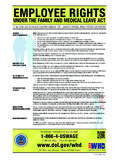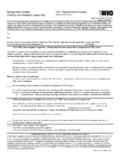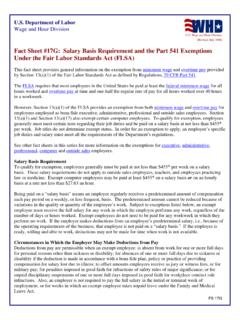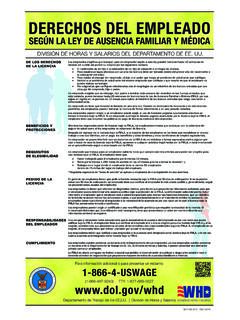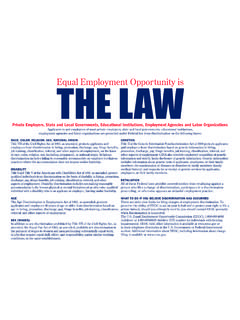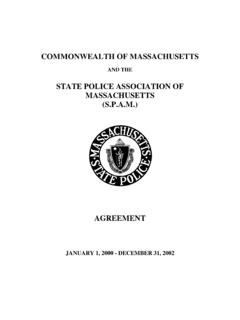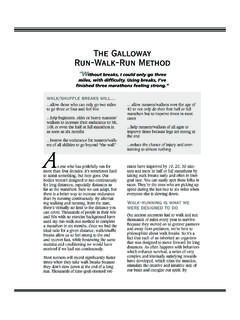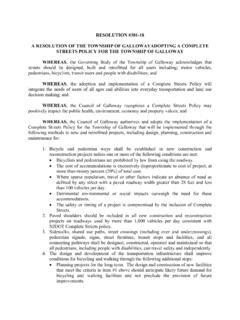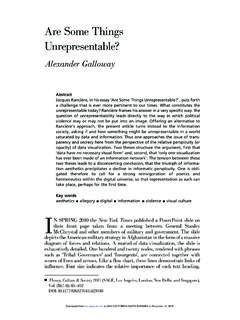Transcription of Indirect Cost Overview Webinar Q&As - Discretionary ...
1 Any follow-up questions, contact either Victor M. Lopez at or Debbie galloway at @dol,gov Indirect cost Overview Webinar Q&As - Discretionary Grantees February 19, 2016 1 1. Hello, I had a question from last week. How can an agency obtain approval for using the De Minimis rate of 10% - what specifically is the process for gaining approval? Response: Assuming that you have never negotiated a Federally approved rate agreement, apply for it as part of completing documentation in the Solicitation of Grant Agreement. 2. If we decide to use the De minimis rate and receive admin reimb based on the 10%, is there ever a time to reconcile what is actual Indirect vs amount received by the De minimis rate? Response: Not for purposes of Indirect cost recovery when using the 10% de minimis rate based on MTDCs (as defined by 2 CFR Part ).
2 Allocable Indirect costs to the non-Federal entity s funding sources could be more, but the chargeable Indirect costs must not exceed amounts over the application of the 10% on MTDCs. 3. Can a sub recipient receive the De Minimis rate if the grantee does not? How would a sub recipient apply for the De Minimis rate? Response: According to 2 CFR Part , a subrecipient is entitled to receive Indirect costs from pass-through entities. Pass-through entities has to either recognize the Federally approved rate that the subrecipient has, negotiate a rate with the subrecipient, or negotiate the 10% de minimis based on MTDCs. Having said that, the subrecipient would apply for the de minimis rate when submitting the proposal budget (inclusive of direct and Indirect costs) to the pass through entity.
3 4. Can a non-profit which contracts for Accounting and Human Resource functions apply for an Indirect cost rate? Response: Yes. Some nonprofits contract out some administrative functions such as accounting and human resources and payroll. Those costs, along with the remaining overhead expenses (such as executive direction, rent & utilities, travel by executive staff, etc.) would be part of the Indirect cost pool in the nonprofit s Indirect cost proposal. Any follow-up questions, contact either Victor M. Lopez at or Debbie galloway at @dol,gov Indirect cost Overview Webinar Q&As - Discretionary Grantees February 19, 2016 2 5. DOL provides my agency largest dollar volume, BUT we have Fed awards that come from National Parks - and therefore we MUST get our rate set by Dept of Interior.
4 Response: According to 2 CFR Part 200, the Federal agency providing the preponderance of direct Federal funds is your Federal cognizant agency for negotiating and approving Indirect costs Federal wide. Appendix IV for nonprofits from that regulation also says that: Once an agency is assigned cognizance for a particular nonprofit organization, the assignment will not be changed unless there is a shift in the dollar volume of the Federal awards to the organization for at least three years. So, you may continue using the rates set by Department of Interior for all of your Federal grants. At some point, however, we may need to transfer back the cognizance to DOL if most of the direct Federal funding continues to come from the Department of Labor.
5 6. We receive WIOA federal funds that are passed through the State of CA and then down to the County level , then to a subrecipient. we have no other federal funds. Who is our cognizant agency? Response - Based on the above, you have no Federal cognizant agency for negotiating and approving Indirect costs. You could, however, negotiate Indirect costs individually with the pass-through entity. 7. Is advertising and public relation activities that directly relate to the program allowable Indirect cost expenses. Response No. See 2 CFR Part Advertising and public relations, for more details. 8. How do you determine which Indirect cost base to use based on overhead? Response 2 CFR Part 200, Appendix IV for nonprofits, states the following Allocation bases.
6 Actual conditions must be taken into account in selecting the base to be used in allocating the expenses in each Any follow-up questions, contact either Victor M. Lopez at or Debbie galloway at @dol,gov Indirect cost Overview Webinar Q&As - Discretionary Grantees February 19, 2016 3 grouping to benefitting functions. The essential consideration in selecting a method or a base is that it is the one best suited for assigning the pool of costs to cost objectives in accordance with benefits derived; a traceable cause and effect relationship; or logic and reason, where neither the cause nor the effect of the relationship is determinable. When an allocation can be made by assignment of a cost grouping directly to the function benefitted, the allocation must be made in that manner.
7 When the expenses in a cost grouping are more general in nature, the allocation must be made through the use of a selected base which produces results that are equitable to both the Federal Government and the organization. The distribution must be made in accordance with the bases described herein unless it can be demonstrated that the use of a different base would result in a more equitable allocation of the costs, or that a more readily available base would not increase the costs charged to Federal awards. Typically, approved allocation bases include: direct salaries and wages, MTDCs or total direct costs. The non-Federal entity has to evaluate the allocation bases and see if allocated Indirect costs using those bases distribute a reasonable share of Indirect costs to the applicable funding sources based on the benefits received concept.
8 We recommend proposing two allocation bases in our Indirect cost guidance for evaluating purposes on this end. The non-Federal entity should propose/select the allocation base for our consideration and approval. 9. Are contracts greater than $25,000 still excluded from the MTDC basis? Response Yes. 10. On MTDC Example, it stated excluding the first $25,000 of contract, I thought the MTDC could only be calculated on the 25,000? Response See below: Modified Total Direct cost (MTDC). MTDC means all direct salaries and wages, applicable fringe benefits, materials and supplies, services, travel, and up to the first $25,000 of each subaward (regardless of the Any follow-up questions, contact either Victor M. Lopez at or Debbie galloway at @dol,gov Indirect cost Overview Webinar Q&As - Discretionary Grantees February 19, 2016 4 period of performance of the subawards under the award).
9 MTDC excludes equipment, capital expenditures, charges for patient care, rental costs, tuition remission, scholarships and fellowships, participant support costs and the portion of each subaward in excess of $25,000. Other items may only be excluded when necessary to avoid a serious inequity in the distribution of Indirect costs, and with the approval of the cognizant agency for Indirect costs. 11. We have had for several years a Federally Approved cost Allocation we switch now to a RATE instead of a CAP. We are a Non-profit entity. Response No. Note that Appendix IV of 2 CFR Part 200 is silent on cost allocation plans (CAPs) for nonprofits. This office has approved CAPs to certain nonprofits based on the proposal submitted, specific funding, and the way they allocate costs.
10 Those nonprofits may continue to use their Federally approved CAPs to allocate Indirect costs. In the future, however, those nonprofits may consider moving into a rate methodology to allocate costs as this is typical for nonprofits and Federal funding agencies expect to see rate support from these entities. 12. Is there a maximum threshold for an Indirect cost Rate? Response No. The proposal, however, must be based on allowable, allocable, and reasonable Indirect costs. 13. My understanding is that if an institution has not negotiated a new rate since the OMB Uniform Guidance went into effect, an institution could not receive an extension. Is that corect? Response Assuming referring to guidance at 2 CFR Part 200, (g) (shown below), yes, that is correct.
